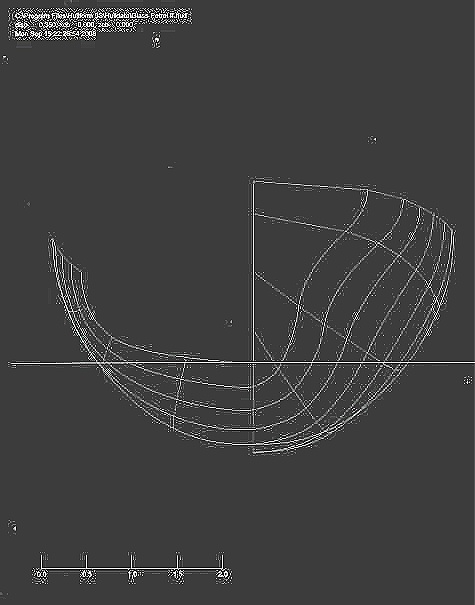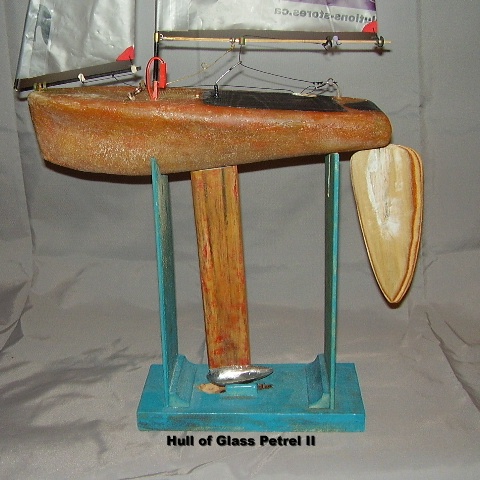Has anyone worked out any approximate figures for the optimum areas for fins and rudders? The wetted area of the hull itself is related to the design and the total weight, I would assume. This suggests that gains might be made by reducing the (wetted) area of fin and rudder.
My latest design seems slow, but the area of fin and rudder is beginning to seem too large. She points and steers well, but…slow.
Rod
For what it’s worth, I typically use a fin shord of about 37 mm and a rudder chord of about 30 mm.
I don’t say that these are perfect, but they seem good enough that I tend to stick to them: there are quite enough other variables to play with.
A.
Dear Rod,
I don’t know why your boat “seems slow”, but I can suggest you a simple and fast rule to evaluate an “honest” appendages area.
Based on a careful measurement of existing well known designs these are average figures :
[b]Fin keel side area should be between 6% and 8% of sail area
Total appendages side area ( keel + rudder ) should be between 8% and 11% of sail area[/b]
greater fin area means improved windward performances and slower downwind boat
greater rudder means, of course, good manouvering and a bit more drag
I feel you should compare your appendages area with these numbers in order to assess if you are too low or too high, and to modify the boat accordingly.
A picture of your boat would be useful to give a more detailed suggestion to improve her performances
Let us know !
Have a fair wind
Flavio
Folgore ITA 5
Hi Flavio
Your consice and helpful responses to the various questions raised are greatly appreciated. I will have to see how my boats compare.
Footy photos show keels of various shapes. One shows a very long chord near hull and very narrow near ballast. What guidelines do you suggest?
Frank,
to put it simple these are priorities when designing a keel
1 - the size : side area as % sail area ( let say 7% )
for a 10 dm2 sail, it means o.7 dm2 ( or 75 cm2 )
2 - span : on footy it depends on rating rules ( about 15cm ) max around 20 cm
3 - chord is : area / span ( 75/15 = 5 cm )
4 - aspect ratio is : span/ chord ( 15/5 = 3 )
do be doubled for “mirror effect” of the hull : 3x2 = 6
a good aspect ratio
Now there are only two more parameter to be modified for a trapeze shaped fin keel : taper ratio and sweepback angleboth of them can be adjusted in order to improve lift distribution on the keel, but their effect is very sensitive on low aspect ratio wings ( short span, long chord )
But with a not-squared planform there are other intersting side-effects
If root chord is bigger than tip chord, structural strenght is improved where needed ( near the hull )
The geometric center of the keel is closer to sail center of effort, and in turn, heeling arm is slighty shorter
All considered a taper ratio ( tip chord/ root chord ) between 0.5 and 0.7 is a good compromise between different trade off
have a fair wind !
Flavio
Folgore ITA 5
Flavio
Not ignoring you or your suggestions. I am trying to assemble the information you requested. I am also using the Hullform 9S freeware program to retro-design my Footy.
I had followed my usual practice of ‘build-sail-and-then-design’. I enclose, (I hope!) the Hullform results, as well as before and after pics of the keel and rudder. The wetted surface of the original fin-rudder was 261 sq cm, while the new is 150 sq cm. (The hull wetted surface is approximately 270 sq cm).
The old aspect ratios were fin=13%,rudder=8%, while the new are 20% fin, and 14% rudder. I also reduced the bulb from 140 gm to 80 gms.
So far, I haven’t had a good sail to do any assessment of any benefit.
Rod
To Rod :
please don’t forget that hullform ( as well other softwares ) measure total WETTED surface ( port + starboard )
coefficient of ( appendages/ sail area ) are usually referred to blade SIDE area
- half the wetted surface -
( one side only )
It is not clear to me if you have already considered this point, but in any case I think this detail should be clarified in order to avoid any misunderstanding.
Looking at your model , it seems that the rudder is very big in comparison to keel size, and if used too much , it can act as a brake
You can try to increase fin keel area, and reduce the rudder.
In any case the best test is a comparison, side by side, with another already tested model in order to have a full picture of the situation ( sails, ballast, and so on )
all the best to you
flavio
folgore ita 5
to rod,
I have noticed only now, that you made mention your ballast is 80 gr
Now this seems to be a very very low figure even on a light displacement boat
On an average footy ( razor, cobra, kittywake ) the average is between 200 and 250 gr
Or something around 50 or 40 % of overall displacement of the boat
May be your boat is slow due to lack of stability
too heavy the hull
too light the ballast
too high the center of gravity
a lot of heel angle even with light wind
not enough driving force
not enough speed
most probably, fin size area is not the point
flavio
folgore ita 5
Flavio
I am concerned about the effects of the wetted area of both sides of fin and rudder, compared with the areas required to prevent excessive side-slipping. There must be some information somewhere relating the consensus of experience bout this.
I am refining my design in the Hullform 9S program and will post as I complete it
Rod


